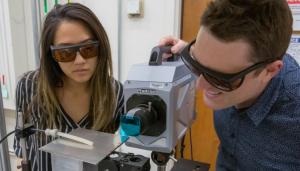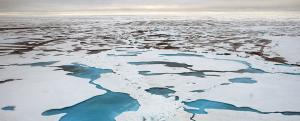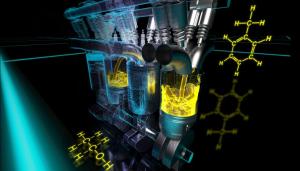LAB REPORT
Science and Technology Making Headlines
March 30, 2018


Energy Secretary Rick Perry hands off a target for an experiment at the National Ignition Facility to Paul Gillie during his visit to Lawrence Livermore National Laboratory this week. Photo by Jason Laurea/LLNL
Energy Secretary comes to town
Energy Secretary Rick Perry made his first visit to Lawrence Livermore on Monday, praising Lab employees for “making a difference in people’s lives” and reaffirming DOE’s commitment to securing the future of its national laboratories.
Perry made the remarks during a joint all-hands meeting with the National Nuclear Security Administration’s (NNSA) Livermore Field Office and Sandia National Laboratories, part of a whirlwind West Coast swing that included stops at Lawrence Berkeley National Lab and the Stanford Linear Accelerator. Speaking before a packed auditorium, Perry focused much of his talk on LLNL’s supercomputing capabilities, particularly its application to veterans’ health issues such as post-traumatic stress disorder and traumatic brain injury).
“What you’re doing in a lot of different areas has the potential to change the world,” Perry said. “The computational capacity, what you have the potential to do, is nothing less than world-changing. This Lab is going to be part of a story, it may not be 10 years from now -- it may be sooner than that, of how people’s lives really get affected in a positive way.”


The Watchman detector would be placed in an excavated cavern 1,100 meters below ground at the Boulby mine in the United Kingdom and is slated to become operational in approximately 2023.
Hey, watch this, man
A new project to develop the first detector able to remotely monitor nuclear reactors also will help physicists test the next generation of neutrino observatories.
The initial project is called Watchman (WATer CHerenkov Monitor of Antineutrinos) and will be built by a large collaboration between researchers in the United States and United Kingdom, led by Lawrence Livermore National Laboratory. The collaboration, dubbed the Advanced Instrumentation Testbed, or AIT, is funded by the DOE's National Nuclear Security Administration.
Nuclear reactions produce telltale antineutrinos -- the antimatter counterpart of neutrinos. The new detectors will be designed to measure the energy of such antineutrinos and the direction from which they come, allowing monitoring of reactors from a distance of 25 kilometers to verify nonproliferation agreements. This project will lay the groundwork for larger detectors capable of monitoring reactor operations from a distance of several hundred kilometers, helping nations track or restrict the production of fissile materials that can be used in nuclear weapons.


By using laser-generated, hologram-like 3D images flashed into photosensitive resin, researchers at LLNL, have discovered they can build complex 3D parts in a fraction of the time of traditional layer-by-layer printing.
Better building through 3D printing
3D printing allows engineers to custom build intricate structures impossible with traditional manufacturing, but the layer-by-layer approach can be slow and limits the shapes that can be built. A new technique can now fabricate entire 3D shapes in seconds using holographic light fields.
The technique, developed by researchers at Lawrence Livermore, uses special resins that solidify when they are exposed to light. By shining three laser beams at a vat filled with the resin to create a 3D pattern of light, they were able to fabricate 3D structures in one go in just 10 seconds.
“This is the first demonstration of a practical way of making 3D parts all at once,” LLNL engineer Maxim Shusteff said. “It’s the next step in the progress of additive manufacturing technology.”


Extent of Arctic sea ice in September 2016 versus the 1981-2010 average minimum extent (gold line). Through satellite images, researchers have observed a steep decline in the average extent of Arctic sea ice for every month of the year. Image courtesy of NASA.
Weather to the extreme
The amount of ice formed in the Arctic was near an all-time low over the winter that just ended, part of a warming phenomenon that some experts believe has increased the likelihood of severe weather like the recent Nor’easters or droughts in the Southwest.
Sea ice is believed to have reached its maximum extent over the Arctic Ocean on March 17, at 5.59 million square miles. That is the second lowest in the 39 years that satellite images have helped make measurements, slightly ahead of last year's total. The four lowest seasonal totals for Arctic ice have all come in the last four years.
The extent of sea ice is tracked closely by researchers and is being connected by some scientists to unusual weather hundreds of miles to the south, including drought in California. These researchers say that although it would be wrong to cite warming as the cause of any single weather event, the likelihood of extreme weather has increased as temperatures in the Arctic jump up.
“The recent California drought appears to be a good illustration of what the sea-ice driven precipitation decline could look like,” said LLNL scientist Ivana Cvijanovic, who published a recent study on Arctic sea ice loss tied to drier California climate.

An artist's rendition of an internal combustion engine with fuel molecules. Image by Adam Connell/LLNL
Internal combustion engines hit the gas
Scientists at Lawrence Livermore are developing models of high-performance fuels to see how they would perform in advanced internal combustion engines as part of the Department of Energy’s Co-Optimization of Fuels & Engines initiative.
The initiative’s goal is to improve air quality, reduce energy consumption and lower drivers’ costs.
Research has shown new fuel blendstocks have the potential to improve vehicle fuel economy in passenger vehicles optimized with advanced gasoline engines by 10 percent. The Laboratory’s scientists will identify the key fuel properties that enable high efficiency and performance in advanced combustion engines.





